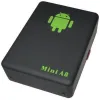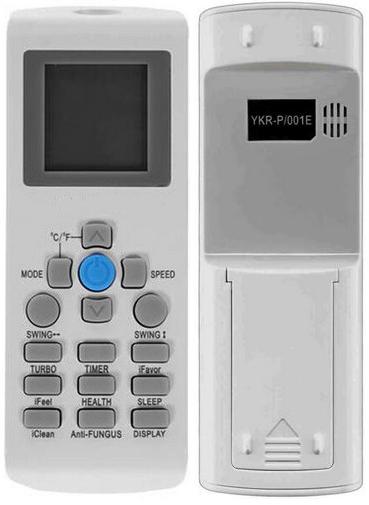
User manual for the universal remote control for Centek YKR-P/002E (YKR-P/001E) air conditioners
Руководство / инструкция

Remote Control for Centek Split-System YKR-P/001E (YKR-P/002E). Operating Instructions
Please read this manual carefully before operating the device, as it contains important information for correct and safe use. Keep this manual for future reference.
The manufacturer is not responsible for any damage resulting from misuse of the device, failure to follow the rules and conditions stated in this manual, or attempts at unauthorized repair.
Air conditioning systems of the “Split” type (hereinafter referred to as the split-system) must be installed only by qualified specialists.
❗👉➨ Do not attempt to install the unit yourself. Improper installation may lead to malfunction or damage to the device!
The Centek YKR-P/001E (YKR-P/002E) remote control is compatible with the following models:
Centek CT-65U10
Centek CT-65U13
Centek CT-65U18
Centek CT-65U24
Centek CT-65E07+
Centek CT-65E09
Centek CT-65E12
Centek CT-65E18
Centek CT-65E24
Centek CT-65Z10
Centek CT-65Z13
Centek CT-65Z18
Centek CT-65Z24 .
Safety Precautions
➠ The remote control is not a toy. Do not allow children to play with it and avoid using it for entertainment purposes.
➠ When operating the remote control, point its signal transmitter towards the indoor unit of the air conditioner while pressing the buttons. The indoor unit confirms signal reception with a short beep.
➠ The signal can be received at a distance of up to 8 meters in a straight line from the indoor unit, at an angle of up to 45° to the left and right. There should be no obstacles between the remote control and the unit.
➠ Keep the remote control at least 1 meter away from television and radio equipment.
➠ Do not drop the remote control or subject it to strong impacts. Protect it from direct sunlight, keep it away from heat sources, do not expose it to water, and avoid storing it in places with high humidity.
➠ Do not use sharp objects to press the buttons, as this may damage the remote control. Do not clean it with gasoline, solvents, chemically treated wipes, or similar agents.
➠ If the remote control does not function properly, remove the batteries, wait 30 seconds, and reinstall them. If it still does not work, replace the batteries.
❗👉➨ Remove the batteries if the remote control will not be used for a long period of time.
Designation of Remote Control Elements and Their Functions
The illustration shows a standard remote control with all functional buttons. These may slightly differ from the buttons on your remote control depending on the model.
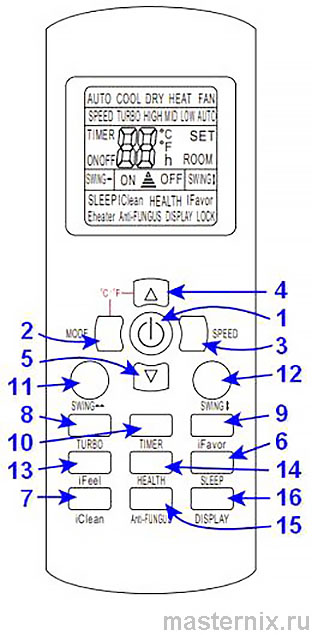
❗👉➨ Attention Depending on your air conditioner model, some buttons on the remote control may be non-functional.
1. ON/OFF (Power Button)
Pressing this button turns the air conditioner on, and the “ON” indicator appears on the remote display. Pressing it again turns the unit off, displaying “OFF” on the screen. When turned on, the air conditioner resumes its previous settings.
2. MODE (Mode Selection)
Each press changes the operating mode in the following sequence:
... → AUTO (Automatic) → Cool → Dry → Heat → Fan → ...
❗👉➨ In cooling-only air conditioners, the heating mode is not available.
When first powered on, the device defaults to AUTO mode.
In automatic mode, the air conditioner selects cooling or heating based on the indoor temperature, maintaining optimal comfort. The target temperature is not displayed on the remote control screen and cannot be adjusted.
In fan mode, only the indoor unit’s fan operates. The air conditioner does not regulate room temperature in this mode. The target temperature is not displayed and cannot be changed.
❗👉➨ Attention The air conditioner does not supply fresh air.
..
3. SPEED (Fan Speed)
Each press changes the fan speed of the indoor unit (airflow speed) as follows:
... → Automatic → Low → Medium → High → ...
The remote control display shows the corresponding fan speed:
... - "AUTO" (Automatic) - "LOW" - "MID" - "HIGH" - ...
Automatic fan speed depends on the difference between the target temperature and the ambient air temperature.
❗👉➨ In fan mode, the automatic fan speed function is not available.
4.  Temperature Increase Button
Temperature Increase Button
Each press increases the target temperature by 1°C, within the range of +16°C to +32°C. The set target temperature is shown on the remote control display and on the indoor unit’s front panel.
5.  Temperature Decrease Button
Temperature Decrease Button
Each press decreases the target temperature by 1°C, within the range of +16°C to +32°C. The set target temperature is shown on the remote control display and on the indoor unit’s front panel.
6. SLEEP (Sleep Mode)
Pressing this button activates sleep mode. The “SLEEP” indicator appears on the remote control display, and the indoor unit’s front panel display turns off. In this mode, the indoor unit fan operates at low speed, and the temperature maintained by the air conditioner changes as follows:
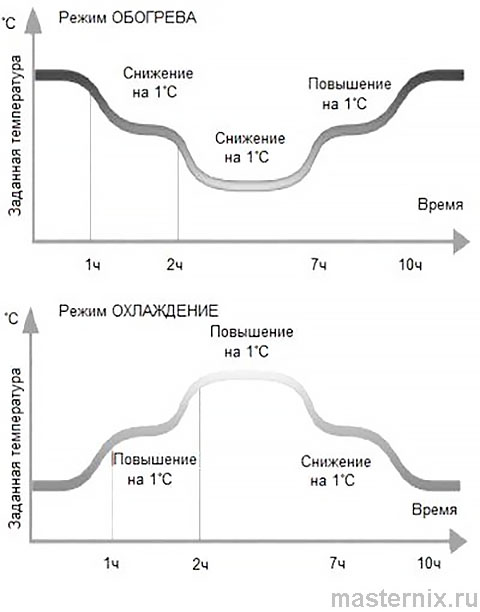
Sleep mode is deactivated when the air conditioner is turned off or when the button is pressed again.
7. iCLEAN (Cleaning)
Pressing this button while the air conditioner is turned off activates the indoor unit cleaning mode. The “iCLEAN” indicator and “CL” symbols will appear on the remote control display, while “CL” symbols will be displayed on the indoor unit’s front panel. This cleaning process removes moisture from the evaporator surface and internal cavities of the unit.
Moisture removal prevents the growth of bacteria and mold inside the unit. The cleaning cycle duration is 35 minutes.
The mode will be deactivated if the air conditioner is turned off or the button is pressed again.
8. TURBO (High Power Mode)
Pressing this button while the air conditioner operates in cooling or heating mode activates high power mode. The indoor unit fan runs at maximum speed to achieve the target temperature as quickly as possible. The “TURBO” indicator will be shown on the remote control display.
High power mode is deactivated when the operating mode changes, the fan speed is adjusted, or the TURBO button is pressed again.
9. iFAVORIT (Favorite)
This button activates the “iFAVORIT” function, which recalls the user’s preferred air conditioner settings.
Pressing the button while the air conditioner is operating applies the pre-stored settings, and the “iFAVORIT” indicator will appear on the remote control display. Pressing the button again restores the settings active before the mode was engaged.
To store preferred settings, first adjust the air conditioner to the desired parameters, then press and hold the iFAVORIT button for more than three seconds. Successful saving is confirmed by the “iFAVORIT” indicator flashing three times.
10. TIMER (Timer)
Setting the Air Conditioner On Timer (TIMER ON)
Pressing the TIMER button while the remote control is off activates the On Timer function. The “TIMER ON” indicator and the timer setting will appear on the display. The time can be set from 0.5 hours (30 minutes) to 24 hours.
To adjust the desired time, press the  (4) or
(4) or  (5) buttons. Each press changes the time by 0.5 hours (30 minutes). Once the timer is set above 10 hours, each press changes the time by 1 hour.
(5) buttons. Each press changes the time by 0.5 hours (30 minutes). Once the timer is set above 10 hours, each press changes the time by 1 hour.
To activate the On Timer, press the TIMER button again. The display will show the air conditioner settings that will be used after automatic start. These settings can be modified if necessary.
After the set time, the air conditioner will automatically turn on with the specified settings.
Setting the Air Conditioner Off Timer (TIMER OFF)
Pressing the TIMER button while the remote control is on activates the Off Timer function. The “TIMER OFF” indicator and the timer setting will appear on the display. The time can be set from 0.5 hours (30 minutes) to 24 hours.
To adjust the desired time, press the  (4) or
(4) or  (5) buttons. Each press changes the time by 0.5 hours (30 minutes). Once the timer is set above 10 hours, each press changes the time by 1 hour.
(5) buttons. Each press changes the time by 0.5 hours (30 minutes). Once the timer is set above 10 hours, each press changes the time by 1 hour.
To activate the Off Timer, press the TIMER button again. After the set time has elapsed, the air conditioner will automatically turn off.
11. SWING 1 (Vertical Louver Swing)
Pressing this button activates the swing function for the vertical louvers of the indoor unit, adjusting the airflow direction horizontally. The “SWING 1” indicator will appear on the remote control display. Wait until the louvers reach the desired position, then press the button again to stop the swing.
❗👉➨ To prevent damage, do not adjust the louvers manually.
12. SWING 2 (Horizontal Louver Swing)
Pressing this button activates the swing function for the horizontal louver of the indoor unit, adjusting the airflow direction vertically. The “SWING 2” indicator will appear on the remote control display. Wait until the louver reaches the desired position, then press the button again to stop the swing.
❗👉➨ To prevent condensation on the louver, avoid directing airflow downward for extended periods when operating in cooling or dehumidifying mode.
❗👉➨ To prevent damage, do not adjust the louver manually.
13. iFEEL (My Atmosphere)
Pressing this button enables performance control based on the temperature sensor built into the remote control.
The remote control display shows the ambient room temperature at the location of the remote, together with the “ROOM” indicator.
This mode is deactivated when the air conditioner is turned off or the button is pressed again.
14. HEALTH (Health)
Pressing this button activates the ionization mode. The “HEALTH” indicator will appear on the remote control display.
Pressing the button again turns off the ionization mode.
15. Anti-FUNGUS (Mold Prevention)
This function prevents mold formation on the evaporator, which can cause unpleasant odors.
Pressing this button while both the remote control and the air conditioner are off activates the automatic indoor unit drying mode after the air conditioner is turned off. The “AntiFUNGUS” indicator will appear on the remote control display. Activation is confirmed by a series of audible signals emitted after the initial five confirmation beeps.
When this function is enabled, after each shutdown of the air conditioner, the indoor unit fan operates at low speed for an additional three minutes to cool and dry the unit.
During the operation of this function and until it is fully completed, it is not recommended to turn the air conditioner back on.
The mode will remain active for subsequent shutdowns unless the unit is disconnected from the power supply. Disconnecting from power or pressing the button again while both the remote and the air conditioner are off will deactivate the Anti-FUNGUS mode.
Deactivation is confirmed by a series of audible signals emitted after the initial five confirmation beeps.
16. DISPLAY (Display)
Pressing this button turns off the display backlight on the indoor unit’s front panel, and the “DISPLAY” indicator will appear on the remote control display. Pressing the button again turns the backlight back on.
Remote Control Display
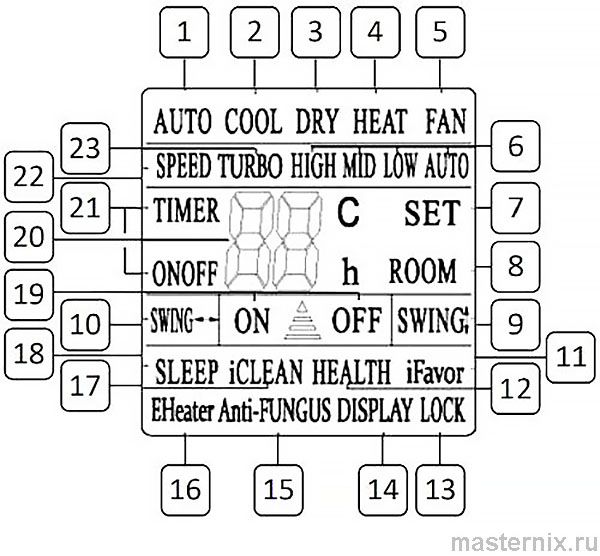
1. AUTO – automatic mode indicator;
2. COOL – cooling mode indicator;
3. DRY – dehumidifying mode indicator;
4. HEAT – heating mode indicator;
5. FAN – ventilation mode indicator;
6. HIGH, MID, LOW, AUTO – fan speed indicators;
7. SET – target temperature indicator;
8. ROOM – room temperature indicator;
9. SWING 1 – vertical louver swing indicator;
10. SWING 2 – horizontal louver swing indicator;
11. iFAVORIT – user’s personal settings activation indicator;
12. HEALTH – ionization mode indicator;
13. LOCK – remote control key lock indicator;
14. DISPLAY – display backlight off indicator for the indoor unit front panel;
15. Anti-FUNGUS – automatic indoor unit drying mode indicator;
16. EHeater – not used;
17. iCLEAN – self-cleaning function activation indicator for the indoor unit;
18. SLEEP – sleep mode indicator;
19. ON/OFF – air conditioner on/off indicators;
20. Temperature value;
21. TIMER ON/TIMER OFF – on-timer and off-timer indicators;
22. SPEED, HIGH, MID, LOW, AUTO – fan speed indicators;
23. TURBO – high power mode indicator.
.
Air Conditioner Operation
Operating Modes Behavior
➠ In cooling or heating mode, the air conditioner maintains the set temperature within ±1°C.
➠ In cooling mode, if the set temperature is lower than the ambient temperature by more than 1°C, the air conditioner will not start.
➠ In heating mode, if the set temperature is higher than the ambient temperature by more than 1°C, the air conditioner will not start.
➠ In AUTO mode, the temperature cannot be set manually. The unit automatically maintains a comfortable temperature of 23±2°C. At 20°C, the air conditioner switches to heating mode; at 26°C, it switches to cooling mode.
➠ In dehumidifying (DRY) mode, the air conditioner maintains the set temperature within ±2°C. If the room temperature is more than 2°C above the set value at startup, the unit will operate in cooling mode.
➠ When the temperature drops more than 2°C below the set value, the compressor and outdoor unit fan stop, while the indoor unit fan runs at low speed.
➠ In “Sleep” mode during cooling, the set temperature automatically increases by 1°C after the first hour and by another 1°C after the second hour, then remains unchanged.
➠ In “Sleep” mode during heating, the set temperature automatically decreases by 1°C after the first hour and by another 1°C after the second hour, then remains unchanged.
❗👉➨ In “Sleep” mode, the TIMER function cannot be activated.
Control Sequence
1. After connecting the air conditioner to the power supply, press the ON/OFF button to turn it on.
2. Press the MODE button to select COOL or HEAT mode.
3. Press the TEMP button.
4. Use the  (4) or
(4) or  (5) buttons to set the desired temperature between 16°C and 30°C.
(5) buttons to set the desired temperature between 16°C and 30°C.
In AUTO mode, the temperature is set automatically and cannot be changed from the remote control.
5. Use the FAN button to select the desired fan speed:
AUTO FAN (automatic), LOW – low speed, MID – medium speed, HIGH – high speed.
6. Use the SWING 1 (11) and SWING 2 (12) buttons to set the louver swing mode. To activate SLEEP, TIMER, TURBO, or LIGHT functions, press the corresponding buttons.
Replacing the Remote Control Batteries
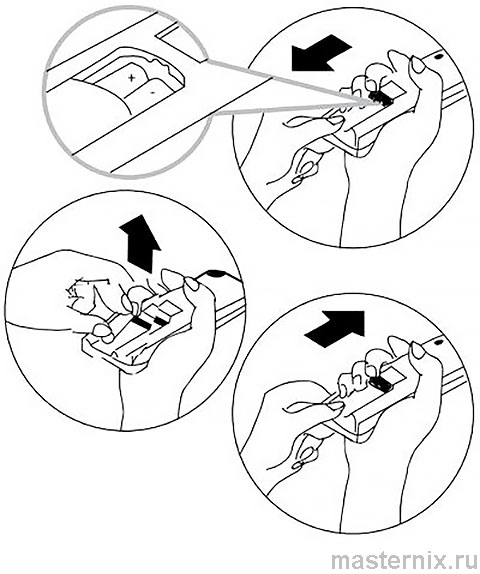
1. Slide the cover on the back of the remote control.
2. Insert two AAA alkaline batteries, ensuring correct polarity.
❗👉➨ NOTE:
➠ Replace the batteries if the LCD display does not light up or if the remote control cannot adjust the air conditioner settings.
➠ Use new AAA batteries.
➠ If you do not use the remote control for more than a month, remove the batteries.
..
Emergency Switch
➠ If the wireless remote control is lost or damaged, the air conditioner can be turned on or off using the emergency switch.
Operating the Air Conditioner Without the Remote Control
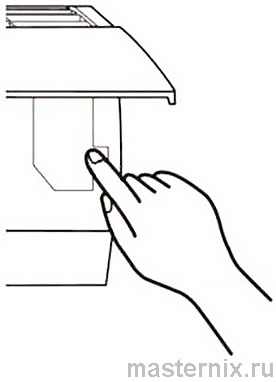
If the remote control is lost or not functioning, follow these steps:
➠ To turn on the air conditioner, briefly press the emergency control button. The air conditioner will start in automatic mode.
➠ Gently close and secure the indoor unit front panel.
➠ To turn off the air conditioner, briefly press the emergency control button again.
❗👉➨ NOTE:
Do not hold the button pressed for a long time, as this may cause the unit to malfunction.
